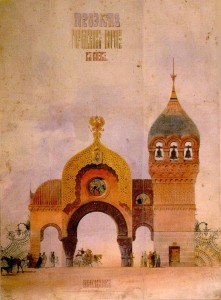
Organ Concert Summons Orchestral Powers, With Visuals
The symphony orchestra wears a coat of many colors, but a good concert organ can give even the biggest instrumental assemblages a run for their sonic money.
On Sunday, the organist of Miami’s Trinity Cathedral will give a vivid demonstration of that as he plays transcriptions for the organ of Modest Mussorgsky’s Pictures at an Exhibition and the Three Botticelli Pictures of Ottorino Respighi. Matthew Steynor also will play pieces by Schumann and the contemporary Dutch composer Ad Wammes, and the whole recital, called Musical Murals, will feature accompanying pictures, shown on a screen at the front of the cathedral.
<!–more–>
Viktor Hartmann’s Great Gate of Kiev sketch, which inspired Mussorgsky. Steynor, a Briton who became director of music at Trinity in 2007, told me his art-inspired organ recital features the Mussorgsky at the request of the audience who heard him play an organ arrangement of Holst’s The Planets last year and were asked to choose from among five orchestral works to hear this year (the Mussorgsky is originally for piano, but it’s much more familiar in the great Maurice Ravel orchestration).
“One of the best things about being an organist is the possibilities for exploring new and unusual colors. The organ at Trinity Cathedral has many varied colors and I’m keen to perform a concert like this on an annual basis to show off all the possibilities of the Trinity instrument,” he wrote in an e-mail message. “I play other recitals of mainstream organ repertoire during the year, but transcriptions of well-known orchestral repertoire provide an opportunity for a broader audience to appreciate the instrument and its capabilities.”
For the Mussorgsky, Steynor is choosing movements from different transcriptions by Keith John and Jean Gillou, and also investigating Cameron Carpenter’s arrangement of the same work for ideas. “I am using whichever arrangement works best for me and Trinity’s organ — sometimes that means a whole movement from one arranger and sometimes I switch within movements, occasionally down to individual measures,” he wrote.
Steynor also said he’s “fairly sure” no one’s attempted an organ transcription of the Respighi trilogy, a lovely work by a popular if underappreciated Italian composer. Steynor arranged the second of the two pieces, The Adoration of the Magi, in 2003, and has now added Spring and The Birth of Venus to complete his transcription. Respighi was a sometime student of Nikolai Rimsky-Korsakov, working with the Russian master in the years from 1900 to 1903, and he learned a good deal about orchestral color from him.
Last year’s Holst concert featured 250 different registrations on the Aeolian-Skinner organ at Trinity, and Steynor wrote that this year’s concert “looks set to top that.” But replicating all of Respighi’s aural shading on the organ has proven to be quite a challenge, one in which the total musical complement sometimes has to be cut back so that important musical ideas can get across.
In Spring, for example, Respighi “calls for a lot of colorful pizzazz which can be difficult to sustain even on a large organ with many different colors. There is, however, the occasional passage where you just have to have everything,” Steynor wrote. “The organist has to get inventive, and so for seven measures in the first movement there is a three-note bass chord which I prepare with pencils, while my right hand plays the ever-present trills and the left hand and feet play a two-voice canon.”
I also asked Steynor whether audiences are likely to see an increasing number of concerts with visual elements, such as this one.
“At last year’s concert I added simple graphics (pictures of the sun, the moon, and the planets) to enhance the program, which I think it accomplished. However, I think adding more complex visuals to music is an art in itself, and certainly while the technology is becoming more commonplace to create something worthy of accompanying high art music, I don’t think musicians will appreciate the animation distracting from their performance,” he wrote.
Sunday’s concert seems to me to be a good one for this kind of multimedia effort, particularly because the two major works were inspired by art: Mussorgsky wrote his piano suite after seeing an exhibit of work by his recently deceased painter friend, Viktor Hartmann, and Respighi obviously drew on the three works by Botticelli for his. It will provide another way for audiences not familiar with organ music to enjoy this recital, and for those of us who already know and admire Steynor’s playing, a chance to hear his achievement in the remarkable art of arrangement.
The concert begins at 6 p.m. Sunday in Trinity Cathedral. More information here: www.trinitymiami.org.
Recent Content
-
Artsarticle ·
-
Artsarticle ·
-
Artsarticle ·

